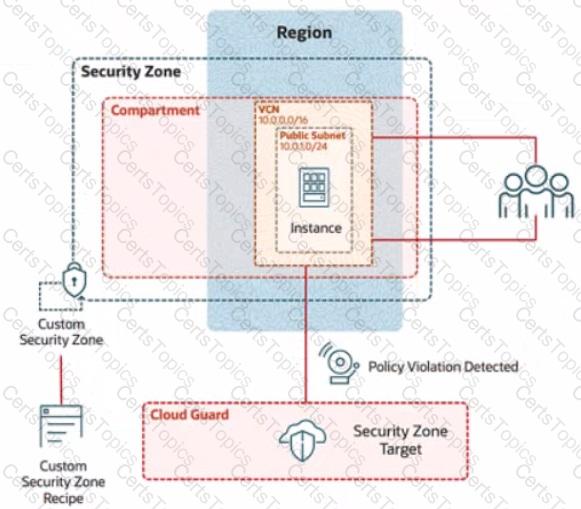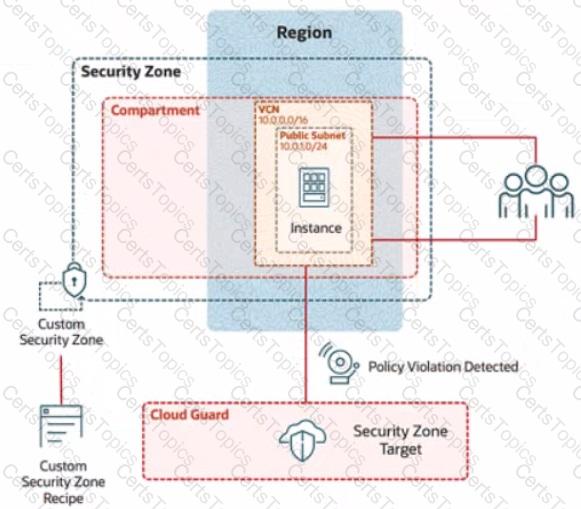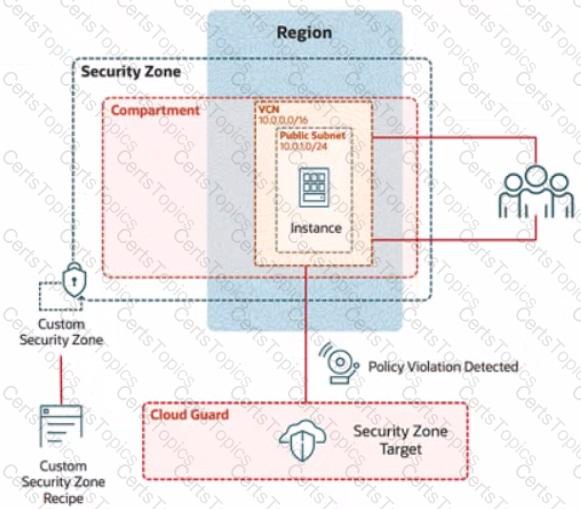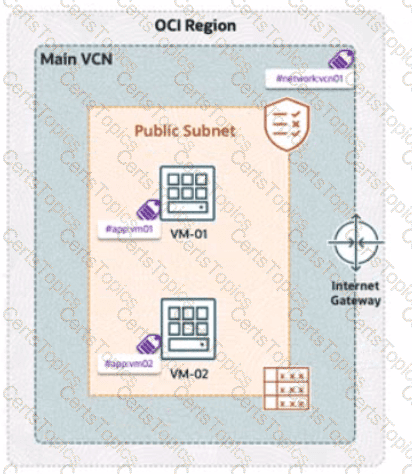Challenge 2 -Task 1
In deploying a new application, a cloud customer needs to reflect different security postures. If a security zone is enabled with the Maximum Security Zone recipe, the customer will be unable to create or update a resource in the security zone if the action violates the attached Maximum Security Zone policy.
As an application requirement, the customer requires a compute instance in the public subnet. You therefore, need to configure Custom Security Zones that allow the creation of compute instances in the public subnet.
Review the architecture diagram, which outlines the resoures you'll need to address the requirement:

Preconfigured
To complete this requirement, you are provided with the following:
Access to an OCI tenancy, an assigned compartment, and OCI credentials
Required IAM policies
Task 1: Create a Custom Security Zone Recipe
Create a Custom Security Zone Recipe named IAD-SP-PBT-CSP-01 that allows the provisioning of compute instances in the public subnet.
Enter the OCID of the created custom security zone recipe in the text box below.
Task 3: Create a Master Encryption Key
Note: OCI Vault to store the key required by this task is created in the root compartment as PBI_Vault_SP
Create an RSA Master Encryption Key (MEK), where:
Key name: PBT-CERT-MEK-01-
For example, if your username is 99008677-lab.user01, then the MEK name should be PBT-CERT-MEK-01990086771abuser01
Ensure you eliminate special characters from the user name.
Key shape: 4096 bits
Enter the OCID of the Master Encryption Key created in the provided text box:
Challenge 2 -Task 1
In deploying a new application, a cloud customer needs to reflect different security postures. If a security zone is enabled with the Maximum Security Zone recipe, the customer will be unable to create or update a resource in the security zone if the action violates the attached Maximum Security Zone policy.
As an application requirement, the customer requires a compute instance in the public subnet. You therefore, need to configure Custom Security Zones that allow the creation of compute instances in the public subnet.
Review the architecture diagram, which outlines the resoures you'll need to address the requirement:

Preconfigured
To complete this requirement, you are provided with the following:
Access to an OCI tenancy, an assigned compartment, and OCI credentials
Required IAM policies
Task 4: Create a Public Subnet
Create a public subnet named IAD-SP-PBT-PUBSNET-01, within the VCN IAD-SP-PBT-VCN-01
use a CIDR block of 10.0.1.0/24 and configure the subnet to use the internet Gateway
Task 2: Create a Compute Instance and Install the Web Server
Create a compute instance, where:
Name: PBT-CERT-VM-01
Image: Oracle Linux 8
Shape: VM.Standard.A1.Flex
Subnet: Compute-Subnet-PBT-CERT
Install and configure Apache web server:
a.
Install Apache
sudo yum -y install httpd
b.
Enable and start Apache
sudo systemctl enable httpd
sudo systemctl restart httpd
2. Install and configure Apache web server:
a. Install Apache
sudo yum -y install httpd
b. Enable and start Apache
sudo systemctl enable httpd
sudo systemctl restart httpd
c. Configure firewall to allow HTTP traffic (port 80)
sudo firewall-cmd --permanent --add-port=80/tcp
sudo firewall-cmd --reload
d. Create an index.html file
sudo bash -c 'echo You are visiting Web Server 1 >> /var/www/html/index.html'
Enter the OCID of the created compute instance PBT-CERT-VM-01 in the text box below.
Challenge 2 -Task 1
In deploying a new application, a cloud customer needs to reflect different security postures. If a security zone is enabled with the Maximum Security Zone recipe, the customer will be unable to create or update a resource in the security zone if the action violates the attached Maximum Security Zone policy.
As an application requirement, the customer requires a compute instance in the public subnet. You therefore, need to configure Custom Security Zones that allow the creation of compute instances in the public subnet.
Review the architecture diagram, which outlines the resoures you'll need to address the requirement:

Preconfigured
To complete this requirement, you are provided with the following:
Access to an OCI tenancy, an assigned compartment, and OCI credentials
Required IAM policies
Task3: Create and configure a Virtual Cloud Network and Private Subnet
Createand configure virtual cloud Network (VCN) named IAD SP-PBT-VCN-01, with an internet Gateway and configure appropriate route rules to allow external connectivity.
Enter the OCID of the created VCN in the text box below.
"Your company is building a highly available and secure web application on OCI. Because of increasing malicious web-based attacks, the security team has mandated that web servers should not be exposed directly to the Internet.
How should you architect the solution while ensuring fault tolerance and security?
You're managing an Oracle Cloud Infrastructure (OCI) environment where a public website hosts downloadable assets stored in Object Storage buckets. These buckets need to be publicly accessible for website visitors, but Cloud Guard keeps flagging them as security risks.
How can Cloud Guard be configured to ignore problems specific to public buckets while still ensuring security checks are applied to other resources that require them?
You are a security architect at your organization and have noticed an increase in cyberattacks on your applications, including Cross-Site Scripting (XSS) and SQL Injection. To mitigate these threats, you decide to use OCI Web Application Firewall (WAF).
Which type of OCI WAF rule should you configure to protect against these attacks?
Which Oracle Data Safe feature enables the Internal test, development, and analytics teams to operate effectively while minimizing their exposure to sensitive data?
A company has deployed OCI Zero Trust Packet Routing (ZPR) to secure its network. They have two compute instances, VM1-01 and VM-02, in a public subnet. VM-01 is tagged with the security attribute app:vm01, and VM-02 is tagged with app:vm02. The VCN is labeled with network:vcn01, The ZPR policy states:


"What is the expected outcome of this policy?